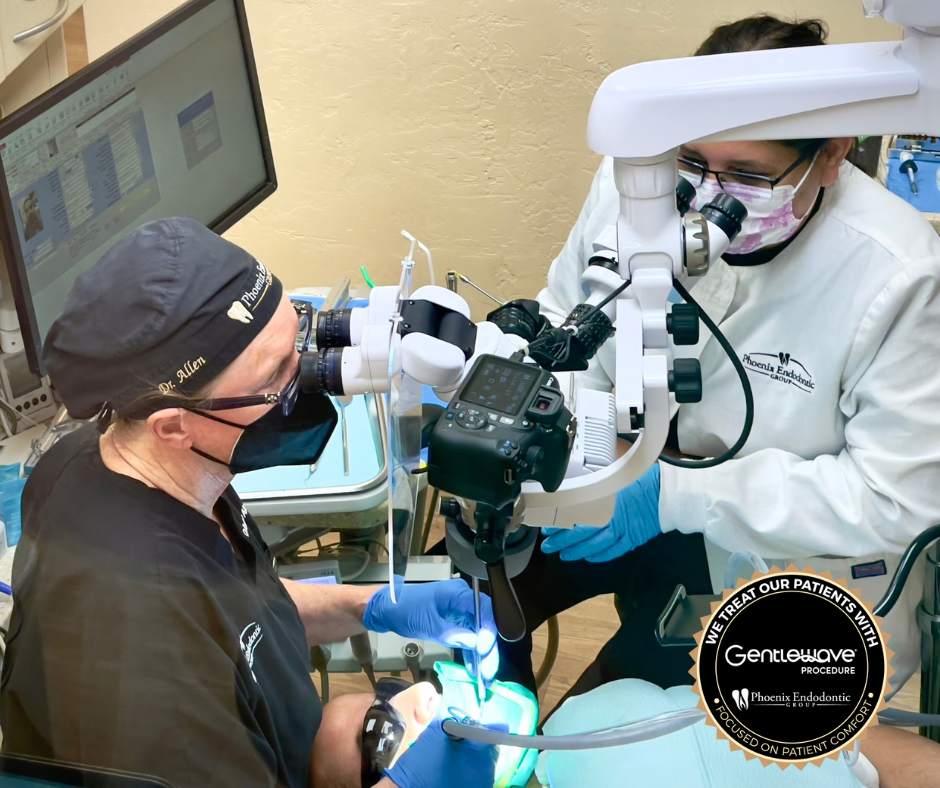
by Dr. Jacqueline S. Allen | Aug 7, 2023 | Blog, Endodontist, GentalWave, Root Canal
Phoenix Endodontics Group treats patients using the most up-to-date technology. We do this because advances inevitably bring a better experience and better post-treatment outcomes for patients.
If you come to us for a root canal, we are likely to suggest the GentleWave Procedure. Let’s look at why we prefer GentleWave technology over traditional approaches to root canals.

GentleWave – Best Current Root Canal Therapy?
1. The GentleWave Procedure leverages fluid dynamics to flush root canals clean. A traditional root canal relies on cleaning with files and other special instruments. If a spot is missed, or a canal is hard to find, some infection can remain. GentleWave’s cascade of tiny imploding bubbles more completely removes biofilm, bacterial infection, and other material from the tooth.
2. The GentleWave Procedure reaches and shakes loose debris that even skilled endodontists miss. For complex root canal systems, treatment using the GentleWave Procedure provides extra assurance that all surfaces have been cleaned and disinfected.
3. The GentleWave Procedure is less invasive than traditional root canal therapy. For those with dental anxiety, root canals can be challenging. With GentleWave, there is less scraping and tapping in the canals and less pain, resulting in a less stressful experience.
4. The GentleWave Procedure requires less time for treatment and recovery. Our patients are pleased that their root canal therapy can be completed in one session most of the time! (They will still need to promptly see their general dentist for a crown to complete restoration.) They are also happy to find they are able to return to their usual activities more quickly than after a traditional root canal, too.
“Our implementation of the GentleWave Procedure for root canal therapy has been a win-win for our practice and our patients,” says Dr. Jacqueline S. Allen, an endodontist at Phoenix Endodontic Group. “We are able to provide a more comprehensive, less invasive treatment, and patients benefit from faster treatment and reduced recovery times with less pain and anxiety.”

by Dr. Jacqueline S. Allen | Jun 19, 2023 | Blog, Endodontics, Endodontist, Root Canal
Time is precious. That’s why, even when a natural tooth needs saving through a root canal procedure, we typically want to know how much time we’ll need to commit to the endodontist. Depending on the condition of your tooth, which tooth is getting the root canal, and a host of other factors, the amount of time needed for the root canal can vary considerably.
Here’s a brief look at some things that can impact the time required for your root canal – including care before and after the procedure itself.

Factors That Impact How Long A Root Canal Procedure Takes
1. The preliminary examination before your root canal procedure. This appointment is needed to confirm the diagnosis and help your endodontist plan your treatment.
2. You may need antibiotic treatment before your treatment. If your tooth is badly infected, you’ll need to complete a course of antibiotics before your root canal. This can delay your appointment or make the treatment itself more complicated.
3. Before the root canal itself, your endodontist will prepare your tooth. Before the actual cleaning of the tooth roots, your endodontist will have the area around the impacted tooth numbed with local anesthesia. Then a dental dam – a small sheet of latex or another material – will be placed to isolate the tooth and keep the area clean.
4. Root canal treatment itself can take anywhere from 30 to 90 minutes. This includes cleaning the root canals, flushing them with a disinfecting agent, and placing a temporary filling. Teeth with multiple roots may take longer.
5. After the root canal treatment, you’ll need to schedule a follow-up appointment to place a permanent restoration. To provide extra protection from reinfection or additional damage, a crown is the necessary final step in the root canal process. It’s important to get a crown placed quickly to protect against new infection and ensure the root canal treatment succeeds.
“At our practice, we understand our patients have busy lives, so we provide an estimate of how long their root canal should take, from start to finish,” says Dr. Jacqueline S. Allen, who practices at the Phoenix Endodontic Group. “We welcome questions about our time estimates and any additional steps they may want to take at home before or after the procedure.”

by Dr. Jacqueline S. Allen | May 10, 2023 | Blog, Endodontics, Endodontist, Save Your Tooth Month
Recent years have brought amazing advances in dental care. Veneers, crowns, and even dental implants are available to restore or replace many functions of natural teeth. Perhaps the most important advances of all relate to saving natural teeth, allowing you to use them for your entire lifetime.
The American Association of Endodontists (AAE) designates May as its “Worth Saving” public awareness month. This awareness campaign highlights the role that endodontists, who are highly trained dental specialists, play in saving natural teeth through root canal treatments and other techniques.

Reasons Natural Teeth Are Worth Saving
Given the replacement or restoration options dental professionals have when a natural tooth is compromised by decay or injury, why do endodontists work so hard to save your teeth?
1. Most people want to save their natural teeth. In a survey sponsored by AAE, 95 percent of respondents said it is important to save their natural teeth. In fact, nearly a quarter of Millennials (born 1980-1996) said saving their natural teeth is their top concern about saving or restoring their body.
2. Natural teeth have benefits that artificial restorations cannot mimic. Natural teeth have connections to the gum tissue around them through the periodontal ligament and an epithelial attachment. These connections help teeth adapt to changes when chewing or talking and also help sustain gum health. Dental implants lack these connections.
3. Treatments to save teeth are less invasive. A root canal treatment has less impact on your mouth than an extraction or implant. Your post-procedure pain and recovery time is also lessened.
4. Root canal treatments are often overall less costly. Teeth extraction by itself is not expensive, but implants can cost thousands, even if only one or a few teeth need replacement.
5. Treatments to save natural teeth are more cost effective. A 2009 British study determined that for a tooth that could be saved with a root canal treatment or a re-treatment of a previous root canal, the lifetime costs of endodontic treatment were equal or less than replacing it with an implant.
“Our natural teeth are designed to last a lifetime, and they can last a lifetime, with proper care and the assistance of endodontists if a tooth is badly infected or injured,” says Dr. Jacqueline S. Allen, who practices with the Phoenix Endodontic Group. “Our staff welcomes you to discuss your case with us. We’re happy to help you experience the benefits of saving your natural teeth.”

by Dr. Jacqueline S. Allen | Mar 21, 2023 | Blog, Endodontics, Endodontist, Phoenix Endodontic Group, Root Canal
Pain sends many patients to the dentist. This is certainly the case when it comes to patients who need root canals. However, not feeling pain does not mean you don’t need a root canal.
Root canals are an endodontic technique to preserve natural teeth that have irreversible pulpitis, an infection of the nerve pulp of a tooth not able to be treated successfully. This condition can result from severe decay or an injury to the tooth. Often there is pain, but not always.
Here are a few important reasons to look beyond pain to discover whether your tooth needs a root canal treatment.

Looking Beyond Pain – Root Canal Treatment
-
Your endodontist is looking for infection as the cause of your troubles, not pain. Inflammation in the tooth’s nerve pulp is the cause the endodontist is looking for. Pain can accompany inflammation, but it is not a reliable guide to diagnosis.
-
Pain is only one symptom of needing a root canal. Other symptoms include teeth that are sensitive to heat or cold, swelling of the face or gums, or teeth that become gray or discolored.
-
Your infection may be draining, perhaps temporarily reducing pain, but also pouring foul toxins into your mouth. A pimple on the gum, called a fistula, or other types of pus drainage from the tooth are also symptoms of pulpitis. These conditions may temporarily reduce your pain, but the tooth will still need treatment: a root canal.
-
Pain associated with inflamed nerve pulp can be inconsistent. If your dentist puts you on an antibiotic to deal with an infected tooth, your pain may be relieved. Your pain may go away on its own, but this might be because the nerves in your tooth have died – not because the tooth is healthy again. Some patients who require root canals report “positional pain,” pain that emerges only when they sit up, lay down, or run in place.
“Determining whether a patient needs a root canal can be complex, and pain is only one factor considered in an evaluation,” says Dr. Jacqueline S. Allen, who practices with the Phoenix Endodontic Group. “Regular checkups with your general dentist and referrals to endodontic specialists as needed are the most reliable way to know if your natural teeth need a root canal to save them.”

by Dr. Jacqueline S. Allen | Dec 20, 2022 | Blog, Endodontics, Endodontist, Root Canal
More than 41,000 root canal treatments are performed each day in the United States – more than 15 million each year. Threats to your natural teeth leading to a root canal are not complicated, but each person’s experience of their symptoms can be unique.
Let’s look at some of the causes and symptoms of tooth infections that can result in a root canal. If you experience any of these symptoms, contact your dentist or endodontist immediately to schedule an examination.

The Two D’s Of Tooth Root Infection
Root canal treatment has proven to be one of the most effective ways to deal with infection in the pulp of the tooth. The infection is usually related to two major culprits: damage to the tooth structure that lets in bacteria, or advanced decay reaching the interior areas of the tooth. Such an infection might show in a variety of symptoms.
Symptoms Indicating A Root Canal Is Needed
1. Persistent pain in a tooth. A healthy tooth does not hurt. While tooth pain can require other treatments beyond or in addition to a root canal, constant or recurring tooth pain should definitely prompt a visit to your dental provider.
2. A pimple or “gum boil” near the infected tooth. Dying tissues in the tooth can cause a buildup of fluid under the gum surface. If the boil bursts, the fluid will have an unpleasant taste and odor.
3. Swollen gums near the infected tooth. Your gums may feel tender or look swollen, even if there is no gum boil present. This swelling can be intermittent, so you may not be in the clear even if the swelling goes away for a while.
4. Sensitivity to sources of heat and cold. An infected tooth can feel pain or sensitivity to hot or cold food and drink, even long after you’ve consumed it. The sensation can be anything from a sharp pain to a dull ache.
5. Your tooth feels loose when you touch it. The tooth infection can seep acidic wastes that soften the bone around the tooth needing a root canal, making it feel loose inside your mouth.
6. The tooth is discolored. The roots of a badly infected tooth may be receiving a poor supply of blood, which can make it look darker than usual.
Clearly, it’s difficult to know if you need a root canal without a thorough dental examination. If you have one or more of these symptoms, make an appointment now to get an official diagnosis.
“Symptoms of dental issues requiring a root canal can be highly individualized,” says Dr. Jacqueline Allen, Phoenix Endodontic Group. “Our endodontists will evaluate your symptoms and plan your treatment so you can save your tooth and stop hurting.”

by Dr. Jacqueline S. Allen | Nov 21, 2022 | Blog, Endodontics, Endodontist, Phoenix Endodontic Group, Root Canal
It can be a shock to learn you require root canal therapy to address an injured or infected tooth. If you’ve never been to an endodontist, or don’t have any friends or family who’ve had a root canal, you may naturally have a lot of questions about what to expect.
Understanding the details of root canal therapy can help you come to your first appointment better prepared. Here is a brief overview of the main stages of a root canal.
 The Key Stages Of Root Canal Therapy
The Key Stages Of Root Canal Therapy
-
Confirmation of diagnosis. Your endodontist will confirm your diagnosis when you arrive for your first root canal therapy appointment by reviewing your X-rays and performing a visual inspection of your tooth.
-
Local anesthesia and dental dam placement. The endodontist will numb the area around your tooth with a local anesthetic. They will also place a rubber sheet known as a dental dam around the tooth to keep it clean and dry while they work.
-
Creating an access hole. After the tooth has been prepared and your gums numbed, an access hole will be drilled in the crown of the tooth to allow the dental pulp to be removed.
-
Pulp removal, filing, and cleaning. Once the access hole is created, the endodontist removes the infected tooth pulp, using special instruments to reshape the tooth’s canals and ensure all infected material is gone. Then the inner tooth is treated with antimicrobial washes to remove debris and aid healing.
-
Filling the root canals. This is the step that gives root canal therapy its name. A biocompatible material, usually gutta-percha, is used to fill the canals and prevent future infections.
-
Placement of temporary filling. The first part of the root canal procedure concludes with a temporary filling on your tooth to ensure the tooth heals and bacteria is not re-introduced while your permanent restoration is being fabricated.
-
Placement of permanent filling and crown. Your root canal therapy is not considered complete until a permanent filling is placed on your tooth, AND the tooth is capped with a crown. A crown provides extra protection against infection and shores up the structural integrity of your natural tooth.
“Patients are surprised sometimes to find out that root canal therapy follows a simple, straightforward process,” says Dr. Jacqueline S. Allen, who practices at Phoenix Endodontic Group. “But our profession’s approach to this procedure has been developed and refined for more than 150 years. We’re happy to explain each step in detail, and to address any concerns or questions you may have, every step of the way. We want each of our patients to be comfortable and confident.”












 The Key Stages Of Root Canal Therapy
The Key Stages Of Root Canal Therapy